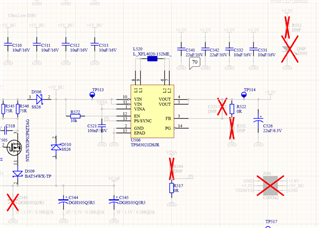Tool/software:
Hey
In the Null-Series production, we discovered in the PCBA componente test that not all the TPS63021 DC/DC converters behave the same regarding the Power-Save Mode. We can identify two clusters of devices, where 3/4 of them switch between the power save and PWM mode as expected (Cluster 1) and 1/4 remain in the power save mode (Cluster 2). The PCBA componente test stimulates a load current >350mA on the 3.3V domain, supplied from the TPS63021, with a static 9Ohm load. All the prototype deveices we produced before behave as expected and switch at approximately 100mA from PowerSave Mode to PWM Mode. Therefore, we first searched for an issue in the assembly of the board. But in the end it came down to the TPS63021 itselfe, which makes the differnce. Besid the voltage level also the input current repective the efficency is differnt between the two clusters.
Cluster 1 :
* TPS Vout: 3.28-3.30V
* Input Current: 372 - 380mA
Cluster 2:
* TPS Vout: 3.38 - 3.46
* Input Current: 405-420mA
Two interesting observations:
* If the device is fully assembed with a CPU module supplied from the 3.3V domain, which causes a similar load current as the test load but with load transients smaller and bigger. All the TPS switch to PWM mode.
* If the PCBs from cluster 2 are modified, so that the TPS is forced to PWM Mode (PS/SYNC pin high) and tested again, Vout and Input Current are equal to the cluster 1 boards.
I did not measure the inductor current but assuming the average inductor current corolates with the output (load current), I would expect that according to the data sheet a switching from PS to PMW mode happens at around 100mA load current.
We implemented the DC/DC converter prety much according the reference desing from chapter 8.1 in the data sheet. 
Now is the question whay do we have observe this two clusters regadeing the 3.3V supply domain. Do we have a misunderstanding of the Power Save mode control of the DC/DC converter, is there a inssue with the TPS63021 devices we sourced for series production or anything else?
Did anybody do similar observations with the PC/PWM switching behaviour of the TPS63021 or has an explonation for the above described behaviour?
Thank you for your respons and help.
Simon


